#about skam peru series
Text
About SKAM PERÚ: Peruvian people’s Geographical views
The National Republic of Peru. La República Nacional del Perú. Informally, we the citizens, like the rest of the world, know it, simply, as Peru. This sovereign country is located in the continent of South America, to the West, with the Pacific Ocean at its coast. Peru is one of the few megadiverse countries in the whole world. Peru’s three official languages are Spanish (Español), Quechua and Aymara. In Peru’s territory is located La Cordillera de Los Andes (The Andes Mountains), though not completely. In this post, I will explain how we Peruvians see and understand our country geographically.
We measure in meters, so in square kilometers, the extension of Peru is:
1.285 million km²
In miles, that is: 798461.982 mi²
Peru’s population is:
32.17 million
In a continental level
Here is a map of South America, with Peru in ORANGE:
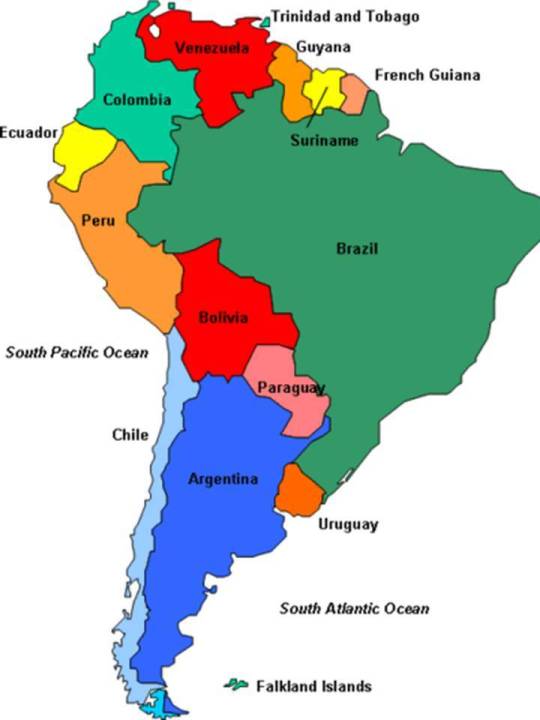
To the north, we border with Ecuador and Colombia. To the east, we border with Brazil. To the southeast, we border with Bolivia. To the south, we border with Chile.
Here is a map of South America, with Peru highlighted:
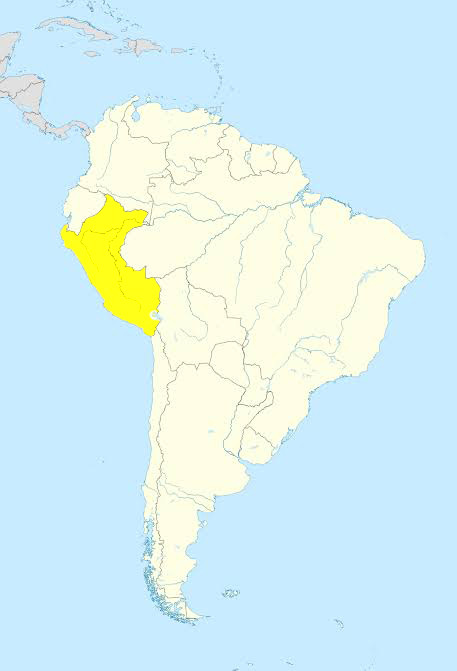
I’ve always thought that Peru has a particular shape, and it kinda does. That’s due to all the territory we lost back in the day when we were at war with Chile (the Pacific War) and the with Ecuador, but that’s history for, maybe, another post.
In a national level
Now, this is the first way children learn to see Peru as a country: the three geographical regions.
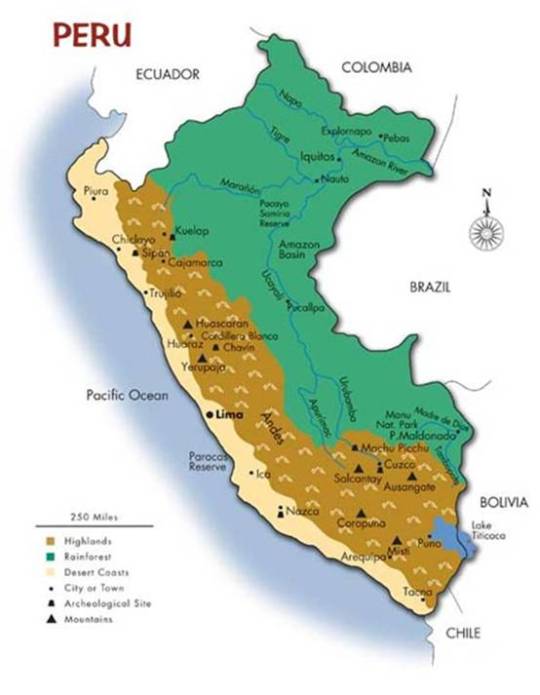
From left to right:
In yellow, we have LA COSTA. The Coast/Desert Coast.
In brown, we LA SIERRA. The Highlands. Here, we encounter The Andes Mountains.
In green, we have LA SELVA. The Jungle/Rainforest. Here, we encounter the Amazonas rainforest.
Oh and some people consider that The Peruvian Sea, EL MAR PERUANO, is the fourth region. This is not universal, though.
I will talk about how stereotypes of people from these regions are in another post.
After that, in Primary School, they teach us a new way to see our country: LOS DEPARTAMENTOS, or, literally, departments. The formal term in English is, I think, the states. In the UK, that would be like the counties.
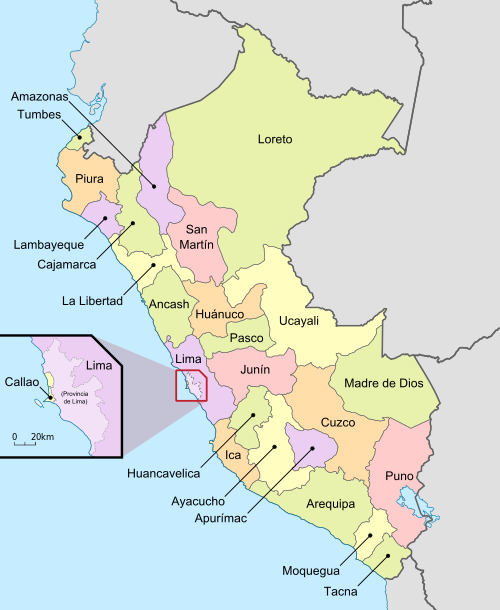
Peru has 24 departments. Here is a list of the departments with their capitals (Department - Capital City):
Amazonas - Chachapoyas
Áncash - Huaraz
Apurímac - Abancay
Arequipa - Ciudad de Arequipa
Ayacucho - Ciudad de Ayacucho
Cajamarca - Ciudad de Cajamarca
Cusco - Ciudad del Cuzco
Huancavelica - Ciudad de Huancavelica
Huánuco - Ciudad de Huánuco
Ica - Ciudad de Ica
Junín - Huancayo
La Libertad - Trujillo
Lambayeque - Chiclayo
Lima - Ciudad de Lima
Loreto - Iquitos
Madre de Dios - Puerto Maldonado
Moquegua - Ciudad de Moquegua
Pasco - Cerro de Pasco
Piura - Ciudad de Piura
Puno - Ciudad de Puno
San Martín - Moyobamba
Tacna - Ciudad de Tacna
Tumbes - Ciudad de Tumbes
Ucayali - Pucallpa
When you combine the three geographical regions with the departments, you obtain this:
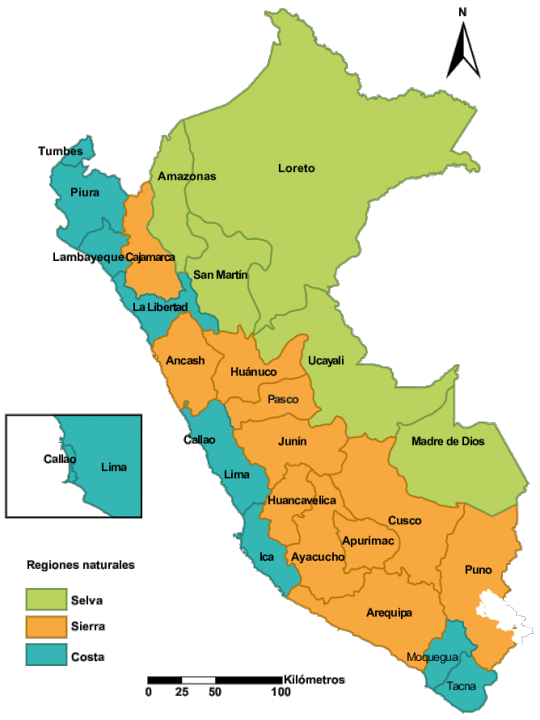
IMPORTANT: Even though Áncash and Arequipa have a coast and, thus, should be included in the Coast region, they are not considered in it. Yes, in the map of the three regions the Coast has no interruptions, but that’s a generalization schools make for little children. A lot of people still view it that way, though, so sometimes that’s a problem. Still, Áncash and Arequipa are considered to be part of the Highlands.
In a department/province level
Departments are divided into provinces. Look at a map of Lima as a department:
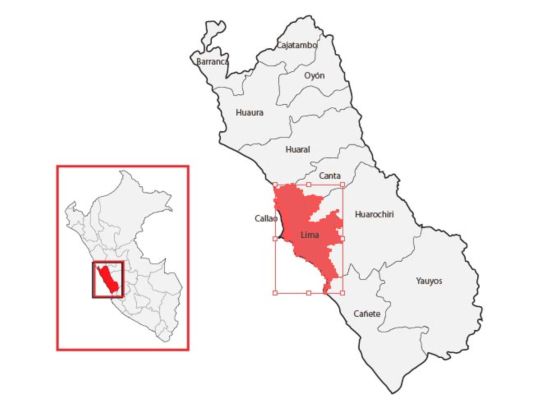
Lima, as a department, has 10 provinces. I, for example, live in the province of Huaura. Let’s take my province as an example of this: provinces are divided into districts. The province of Huaura is divided into 12 districts. I was born in the district of Huacho, three hours from Lima, the capital city of Peru. Almost every district has a city with its same name - for example, my district has a city also called Huacho, which is, actually, where I’m from and currently live in.

In a province/city level
Below the province of Huaura, you have the province of Huaral. Below the province of Huaral, you have the province of Lima. La provincia de Lima. It is essential here to understand that la provincia de Lima is always taken as a whole, and even though it’s a province, all Peruvians refer to it as the capital city, la capital. Why? Historical reasons, I guess. Look at its map:
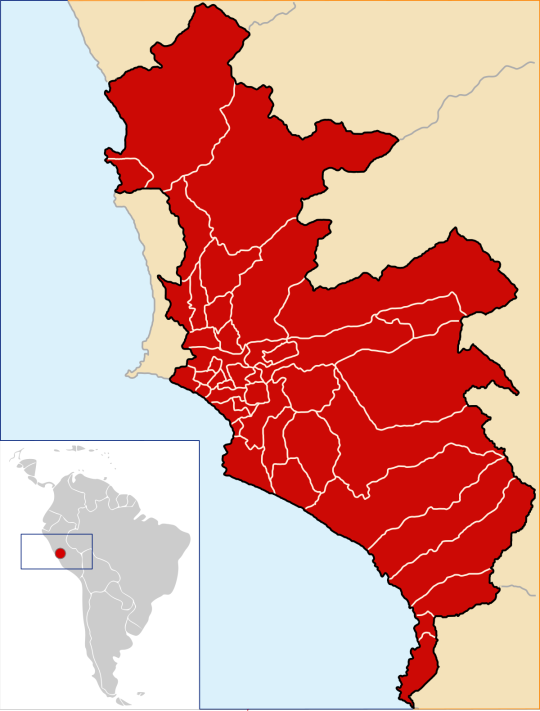
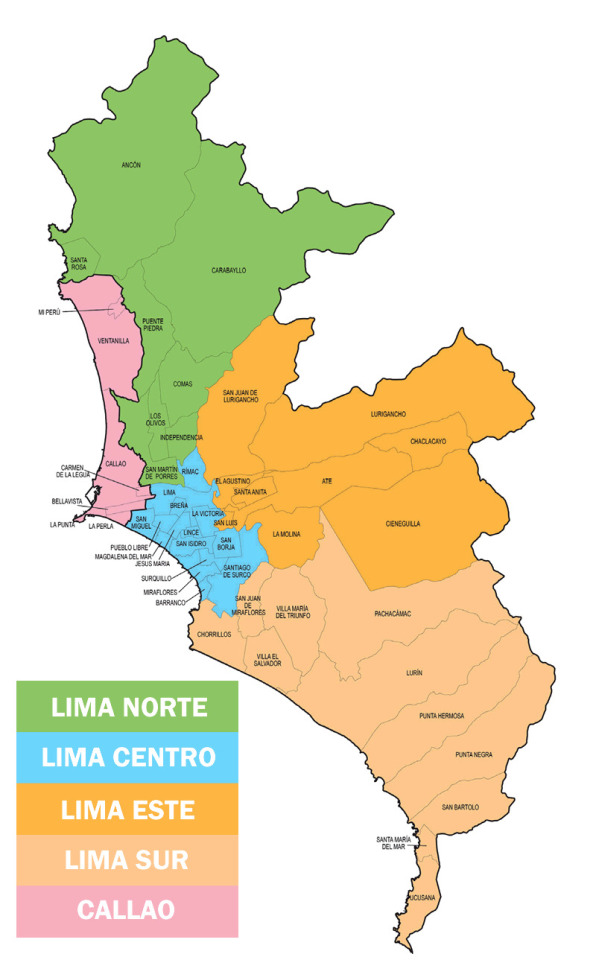
I know, I know, too many districts. That’s the province of Lima, which is so important that has special treatment. People from all over the country refer to it as just Lima, la capital. It is a province, but we all talk about it as a big, big city. I will be referring to it as such (“the city”). Formally, it is divided into 43 districts - one of them is, actually, called Lima as well, and it is located at the center of the province. Then, of course, we have the Constitutional Province of Callao, La Provincia Constitucional del Callao, or just El Callao. This one is special: it has its own government, but it’s still inside Peru and goes by all its laws and Constitution, of course - you can see it up there in the map, in pink, where it is also divided into districts despite being a part of Lima. El Callao is also a port, which has made the province known for fishing - they are big about that. Complicated? For us, not at all.
You can see that, apart from El Callao, Lima is divided into four other sectors. These are not formal - they’re just a way of distinguishing four zones of the city:
Lima Norte, North Lima (in green): Upper part of the city, borders with the province of Huaral and the province of Canta.
Lima Centro, Lima Center (in light blue): Middle part of the city, borders with all the other parts.
Lima Este, East Lima (in deep orange): Side part of the city, the only one with no sea whatsoever. It borders with the province of Huarochirí.
Lima Sur, South Lima (in light orange): Lower part of the city, borders with the province of Huarochirí and the province of Cañete.
Just to count, we have:
Lima, the department, divided into provinces
Lima, the province (also known as “the city”), divided into districts
Lima, the district, also known as Lima Metropolitana nowadays or Cercado de Lima, where the name comes from
Understood? Cool! Let’s have a closer look:
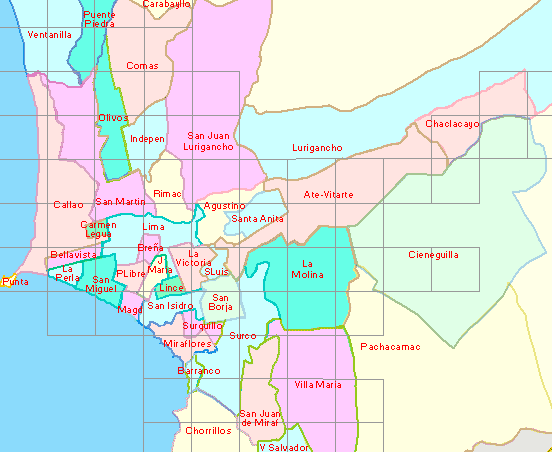
In this new map, you can’t see all the districts, but you’re able to focus on “the main ones.” See, as a lot of cities in the world, Lima is divided by socioeconomic class. It is true that all districts have their share of the middle class and even rich people, but generalization persists. There isn’t a map where you can see this type of division, so I’m going to write it down for you:
The north side (Ventanilla, Puente Piedra, Comas, Los Olivos, San Martín, Independencia, San Martín de Porres, San Juan de Lurigancho, Lurigancho, and even El Callao) is considered as the poor part of Lima.
The center (Lima, Breña, San Miguel, Pueblo Libre, Jesús María, Lince, La Victoria, and even Magdalena del Mar) is considered the middle-class part of Lima, with some traces of the upper-class and, sometimes, the lower-class.
The south side (San Isidro, Miraflores, Barranco and part of Surco) are considered the upper-class part, where all the rich people live.
Part of the east side (Surco, San Borja, La Molina) is also considered for the rich, though, as they border with Santa Anita, Ate Vitarte, San Luis and El Agustino, lower-class districts, can have “poor parts” or a middle-class section.
All the other districts are just a mixture of socioeconomic classes and are also considered for vacation.
When you come from a place outside of Lima, you are considered to come “from a province”, which means “de provincia”, in Spanish - that is, that you can be from the Highlands or the Jungle, or another place in the Coast that isn’t Lima itself (even me, who is from Lima the department, is considered “de provincia”, just because I wasn’t born in Lima the city). That is an informal term that is very commonly used amongst Peruvians. Peru suffers from centralization - Lima is the city that is “centralized.” All the good schools and colleges, hospitals and clinics, theaters and museums, are here. You wanna be someone? Come to Lima. I study in Lima. This centralization makes Lima the “place to be”. A lot of people from all over the country come here in search of opportunities and a brighter future, a better legacy for their families. Like, you have no idea. Lima is so full of people we are in a mild crisis, seriously. Lima is like the American Dream to all the people who were born outside the city. It’s a big statement that, I believe, just a Latin American would understand, because a lot of Latin American countries are centralized.
Two curiosities of Lima as a capital:
- It’s the only capital city in South America that has an exit to the sea.
- It’s the most populated city in Peru, with more than 10 million people, which is almost 10% of the entire population. This also makes Lima one of the most populated cities in Latin America, and places it on the Top 30 of most populated cities in the world.
That’s all, I think. If you have any doubt whatsoever, don’t hesitate to leave it in my ask box - I will be glad to solve it. Please, tell me what you think, and what you would like for me to cover next!
48 notes
·
View notes
Text
Skam Peru is live on Instagram and talking about the series 💞💞
5 notes
·
View notes
Text
Character/Relationship Charts for this series
by aletterinthenameofsanity
Chart of characters for each of the remakes, along with an incomplete list of relationships in this series. Feel free to ask all of the questions you want in the comments about what's going on with the set-up of this 'verse!
Words: 246, Chapters: 1/1, Language: English
Series: Part 24 of if this love is pain (then darling let's love tonight)
Fandoms: SKAM (Norway), SKAM (France), Druck | SKAM (Germany), SKAM (Italy), WTFock | Skam (Belgium), SKAM (Spain), SKAM Austin, SKAM (Netherlands), Skam (Peru)
Rating: General Audiences
Warnings: No Archive Warnings Apply
Additional Tags: Post-Canon, all of the evaks living in Antwerp, Crossover, Crack Relationships, some of them are at least, some OCs
source https://archiveofourown.org/works/23713597
0 notes
Text
Why it's important for Peru's youth to have a Skam remake
Disclaimer: This is an informal essay. I'm not basing any of this on scientific studies, but in my own and other's personal experiences and general knowledge as Peruvian teenagers.
Being a Peruvian teenager is hard, as in every other country in the world. There's few to no representation of the LGBT+ Community, and the Feminism is so criticized and forced on screen that true attempts to make it work are drowned by TV companies who just want to achieve a social agenda that will get them more viewers. We have grown up in a society where, thought it's true that working women are everywhere, a lot of them still think that their children have to ask the father for permission. The political crisis is bigger than ever, with a now non-existent Congress because it was mostly conformed by the opposition political party and didn't want to approve a law that would assure gender approach and sexual education on public and private schools (and that's only the peak of the iceberg). Religion has a great deal to do with that: it's influence is so big here that people can’t get proper education on important matters, such as sexuality, gender equality, civilism and social science.
However, youth is rising. When the Congress tried to approve a law that meant superior institutes students would work for free for almost three years, the march that prevented it was huge and unstoppable. When the most shameful judicial scandal of our history was unveiled, we young people were on the streets, demanding a reorganization of the National Court. Marches and protests are an essential and constantly present event on our daily lives now, even if not all of us participate in them. Chile and Bolivia - not to mention Venezuela - have bigger and and more notorious issues, but that doesn’t make our country invisible. You will never hear a single Peruvian saying that they’re proud of their country because of its Government. We all talk about our delicious food (‘Best culinary destiny of the world!’) and our breathtaking touristic places (Peru: the world’s catalog!’). We always complain about politics and society, thought. Peru is a racist, misogynist, homophobic country who says is inclusive and loves its culture, but has so much centralization that most people don’t know and don’t care about what’s happening outside the capital, Lima. We scream that we’re one of the most biodiverse countries on earth, but not that we're also the least ranked country in Latin America regarding education. In fewer words, were hypocrites.
Now imagine you’ve grown up in this environment: nationalism and occidentalization is everywhere, you say you’re proud of your country because that’s what your family taught you, and, suddenly, you’re thrown into reality. Peru is beautiful, but so wasted that you notice it’s all an act. Mining and external private investments represent the highest economic income, but that money is not well used and the contamination is killing children of blood and lungs diseases. Education in public primary and secondary schools is a joke. There’s a lot of good public colleges, but they’re so inside politics that corruption has rotten their roots and young people do whatever they can to attend private colleges instead. We all wish to get out of this hellhole of a country, and our parents want us to - it's the least we can do, because Peru has no remedy. We're a third world, underdeveloped country, and that's never going to change because people is ignorant and do nothing to invest themselves into politics or society issues. It's sad, and frustrating, so you just want to finish studying, get a job and then fly out of here.
Daily life is another matter. Middle class is the biggest population here, with poverty close at 20 percent or something like that. That means some of us can afford food and some vanities, but not in excess. Supermarkets exist, but markets more common, often visited by middle-low class house wifes who only go to Metro and Plaza Vea - famous supermarkets chains here - when they want to show off or have additional income. Teenagers are so surrounded by American culture and European expectations that save money to shop on the mall and drink Starbucks. Believe me when I say those things are expensive here, because they are. We all want the most cliché stuff you can imagine: Adidas clothes, Converse shoes, Ariana Grande songs and Corona beers. I know that's a lot of generalization, but that's our perception of American and European culture: you're advanced, sophisticated and beautiful. Indigenous people leave their customs and traditions because they wish to be accepted by us, wanna-be's. We teach them to speak Spanish and then English, to dress 'properly' with t-shirts and pants, to not paint their faces and vanish their accent as much as possible. Teenagers are the firsts to fall for all that bullshit, because we think it will make us fit into society seamlessly.
Now, don't get me wrong. We have also learned to respect, but all the unconscious racists and homophobic comments are said too many times as joke to state that we've changed. As I mentioned before, education does anything for this, and a lot of families are very closed-minded. We're raised to believe in heteronormativity and white supremacy as if they were natural laws. Many of us are short, dark-skinned and dark-eyed, so every time we see a tall, blond and blue-eyed person we are awed and have this desire to be like them - they are more accepted, you know, cooler. Our indigenous heritage is something shameful, so that's why we say we're 'half-bloods': yes, we descend from the Incas, but also from Spanish conquerors, so it's all fine. Teenagers dance to reggaeton and pop, but almost none of them to huayno or saya, typical and amazing Peruvian dances. We value our culture, but distance ourselves from it. This new and modern generation is meant to be global, so we don't have to pay attention to them. We drink and smoke, we party and talk about Netflix shows. See? We're like you!
I don't know if my goal of making every person who reads this understand Peruvian context was accomplished. Nowadays, all TV is filled with the same Mexican Telenovelas copies, long, dramatic and unrealistic series that exaggerate society, and trash reality shows that are meant to give us pointless and cheap entertainment. All our pop culture (like going to a minimarket called Tambo and going home on microbuses) is forgotten, avoided, because they'll show the neglected streets, dirty sidewalks and all the other stuff that would put in evidence that we're not as pretty or exotic as the rest of the world thinks. A gay couple who dares to walk and kiss in public is told to leave that place. Sexual assault is diminished and not punished. Islam is almost non-existent and very judged. We need Skam because young people need the representation that awesome show would give us. They could talk about politics because we're also starting to, about feminism because the young women here are not ashamed of it anymore (for the most part), about the LGBT+ Community because homophobic marches and and gender discrimination are allowed and normalized, about other religions besides christianity because the church has to stop it's influence on the Government. My hope for Skam here comes from the wish of a country who is inclusive, multi-colored and respectful of it's multiculturalism. The need of something that shows us as we truly are, flawed but with the possibility of change, is bigger than ever.
#skam#skam italy#skam france#skam españa#skam germany#druck#skam belgium#wtfock#skam nl#skam austin#skam peru#peru
128 notes
·
View notes